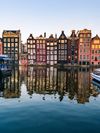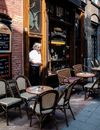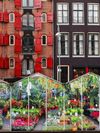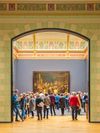
By Kate Bussmann
March 2024
Picturesque canals, colorful gabled houses, and a progressive café culture await—plus the world’s largest collection of Dutch masters
Your essential guide to the best things to see and do in Amsterdam. Find more travel inspiration for more amazing cities here.
Think of Amsterdam and canals, bicycles, and tulips—and certain less salubrious attractions—spring to mind. And they are indeed all here in abundance. Tolerance is the defining characteristic of the Dutch capital—from its proud history of resistance to its progressive café culture and exuberant annual Pride parade, virtually anything goes. That is, with one exception: Tourists who step into the ubiquitous bike lanes without looking can expect an earful of abuse.
A truly beautiful city, from the impossibly pretty canal district, designated a UNESCO World Heritage Site in 2010, to bohemian Jordaan (see map below) and the handsome townhouses around Vondelpark, it has been endeavoring lately to shed its reputation as a party capital. And it’s working: While the coffeehouses and De Wallen’s 600-year-old red light district aren’t going anywhere, increasingly it’s culture that’s the draw, from a diverse music scene to blockbuster art shows.

The “dancing houses” have become a symbol of the city
Built on reclaimed swampland, for centuries this tiny city exercised outsized influence around the world, and never more so than in the 1600s, when its merchant class was made rich through trade in the Indian Ocean. As the horseshoe shape of the old town grew, the canals became lined with tall, colorful, gabled houses announcing through carved decorations the source of their owners’ wealth.
Today, many are lopsided, having sunk on their watery foundations: Take a boat tour along the waterways and look out for the Damrak Canal Houses, also known as the six “dancing houses,” which lean precariously (and picturesquely) into each other.
Amsterdam is a museum-fiend’s dream, with around 75 to choose from. Take a tram to Museumplein to see the big three: the Van Gogh Museum, the Stedelijk Museum for modern and contemporary art (think Mondrian, Chagall), and the Rijksmuseum’s unrivaled collection of Dutch masters, including world-famous works by Vermeer and Rembrandt. Also on most visitors’ lists (be sure to book ahead) is the Anne Frank Huis, where the German-born Jewish author of the most famous diary in history hid with her family during the Nazi occupation. And kids will love the ship-like NEMO Science Museum, designed by starchitect Renzo Piano.
Fly to Amsterdam Airport Schiphol. Hop on the Intercity direct train to Amsterdam Centraal Station, which takes about 15 minutes (pre-book for cheaper fares). If traveling from within Europe, arrive by train at Centraal Station (including the Eurostar from London).
Tipping is not expected, although a 10% tip at the end of a meal wouldn’t go amiss. Dutch is the local language and English is spoken widely. If you want to use some basics, hallo (hello) and bedankt (thank you) are useful starting points.
Amsterdam’s compact center is best explored on foot, or if you want to feel like an Amsterdammer, rent a bike with one of the local apps. The metro and street trams are available across Amsterdam. Taxicentrale Amsterdam (TCA) is the local service, with the usual ride-sharing apps also available. Ferries cross the IJ to the creative Amsterdam-Noord district and are free for pedestrians and cyclists. Most services depart from Centraal Station.
All of Amsterdam’s 39 metro stations are wheelchair-accessible, as are the ferries that cross the IJ. Newer trams also have wheelchair ramps. Amsterdam’s train stations are accessible to those who are blind and visually impaired, with braille signs and tactile maps. The Rijksmuseum offers guided tours for the visually impaired and tours conducted in international sign language.
Amsterdam is a liberal city with a thriving LGBTQ+ community, and is a welcoming, diverse place. Key LGBTQ+ districts in Amsterdam include Amstel, Reguliersdwarsstraat and Kerkstraat. Pride takes place every August, in the city center. Watch the Canal Parade cruise the canals, from Scheepvaart, a maritime museum, towards the Amstel River.
A visit to one of Amsterdam’s “brown cafés” is a must: Closer in spirit to a pub than a coffee shop, they have an informal vibe and late-night hours, and get their name from their cozy, dark-hued decor. We love the Delft tile-lined Cafe ’t Papeneiland, which has occupied its postcard-perfect canal corner location since 1642, and the beer-focused hole-in-the-wall De Pilsener Club.

Head to De Pilsener Club for specialist Dutch brews
For dinner, head to the Nine Streets (see map below), a tiny, picturesque neighborhood in the World Heritage Canal Belt, where you’ll find plenty of excellent, well-priced restaurants, with people-watching thrown in for free. Momenti on Herenstraat serves authentic Italian, while the seasonal menu at Café de Klepel changes daily.
For fine dining, choose the chef’s menu at Breda, or if that’s full, try its little brother Klein Breda. Blown the budget? Choose from the excellent deli selection at supermarket chain Albert Heijn and enjoy a picnic in Vondelpark. Pro tip: Before you take a seat in a bar or restaurant, ask if it’s table service or if you need to pay at the bar; you might find yourself waiting a long time otherwise. And if you find the service a little gruff, don’t take offence—Amsterdammers are famous for their bluntness.
This is a city that loves a party, from the Amsterdam Dance Event (ADE), a four-day festival each October for electronica fans, to King’s Day in April, a raucous national holiday celebrating King Willem-Alexander’s birthday with music, dancing, carnivals and more. Paradiso in north Amsterdam has live music in a former church; for a more sedate experience, take in a free lunchtime classical concert at the Concertgebouw (from September to June), or join the throngs for the Prinsengracht Concert each August, when world-famous classical musicians perform on a pontoon in front of the Pulitzer Amsterdam Hotel.

The floating Bloemenmarkt is a multicolored must-see
Vintage-fashion fans are in for a treat, particularly in the Nine Streets: L’Étoile de Saint Honoré has designer bags galore, while Kath-A-Porter specializes in deadstock and reworked vintage, Concrete Matter has handpicked menswear, and at various branches of Episode, you’ll find an excellent edit of vintage Levi’s.
In spring, head to Keukenhof Tulip Gardens for a quintessentially Dutch souvenir: A mind-blowing 800 varieties of colorful tulips are on display, with most coming into bloom towards late April/May; buy bulbs there or at the famous floating Bloemenmarkt. (Check for an official white sticker on the package if you’re bringing it to the U.S.)
The love-struck teenagers of The Fault in Our Stars fulfilled their bucket-list dreams on the cobbles of Amsterdam, while a little Hollywood sparkle was sprinkled by George Clooney and co. in Ocean’s Twelve, and Sean Connery’s James Bond in Diamonds Are Forever. But for an insight into Amsterdam’s spirit of resistance, watch A Small Light (Hulu, Disney+), which tells the story of Miep Gies, the Dutch woman who risked her life to shelter Anne Frank and her family from the Nazis for more than two years.

Rembrandt’s The Night Watch in its full glory
The ever-evolving Rijksmuseum is home to era-defining works by Vermeer, Hendrick Avercamp’s bawdy Winter Landscape with Ice Skaters, a Vincent van Gogh self-portrait, and an exceptionally realistic Golden Age dollhouse—an intricate tortoiseshell miniaturization of an Amsterdam canal house.
Rembrandt’s The Night Watch, the jewel of the collection, is currently partially obscured due to restoration works. Visit the Michelin-starred Rijks Restaurant, or refuel at the café with an excellent view over the central hall. Download the app for free audiovisual tours, or for modern musical soundtracks (beware: some content is distinctly adult; this is Amsterdam, after all).

Wow museums to see now
From Dubai to Denver, these futuristic attractions will dazzle all the family
Lined with boutiques, vintage stores, restaurants and cafés, this micro-neighborhood forms part of the Canal Belt, the semicircular canals surrounding Centrum (Amsterdam’s old center). The canals that border the Nine Streets—Singel, Herengracht, Keizersgracht, and Prinsengracht—are some of the most handsome in Amsterdam. And you’re spoiled for choice when it comes to hotels.
Formerly a working-class neighborhood, Jordaan is now home to artists, students and entrepreneurs, and while there are tourist attractions here (including museums dedicated to tulips, cheese and houseboats), its real soul is glimpsed by simply wandering its narrow streets and canals. Keep an eye out for hidden hofjes (courtyards), and browse the varied wares of Noordermarkt (open Saturdays and Monday mornings). Anne Frank Huis is just across the canal.

Kate Bussmann is an editor at Expedia Group, covering all aspects of culture and style. She has hosted live and online events, written and edited for titles including The Times, The Telegraph, InStyle, Glamour, and Marie Claire, and appeared on NPR, the BBC and Sky News. She has lived in London, New York and Naples, and one day plans to move to Paris.






